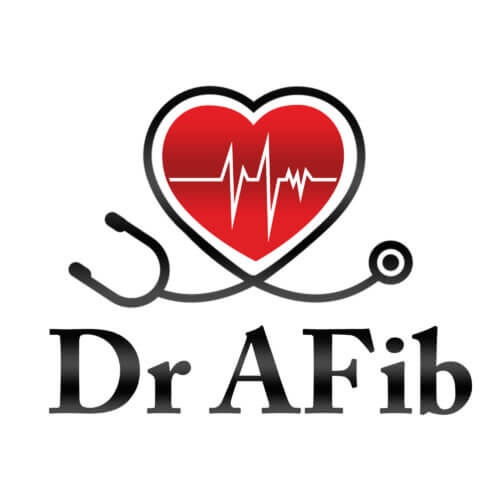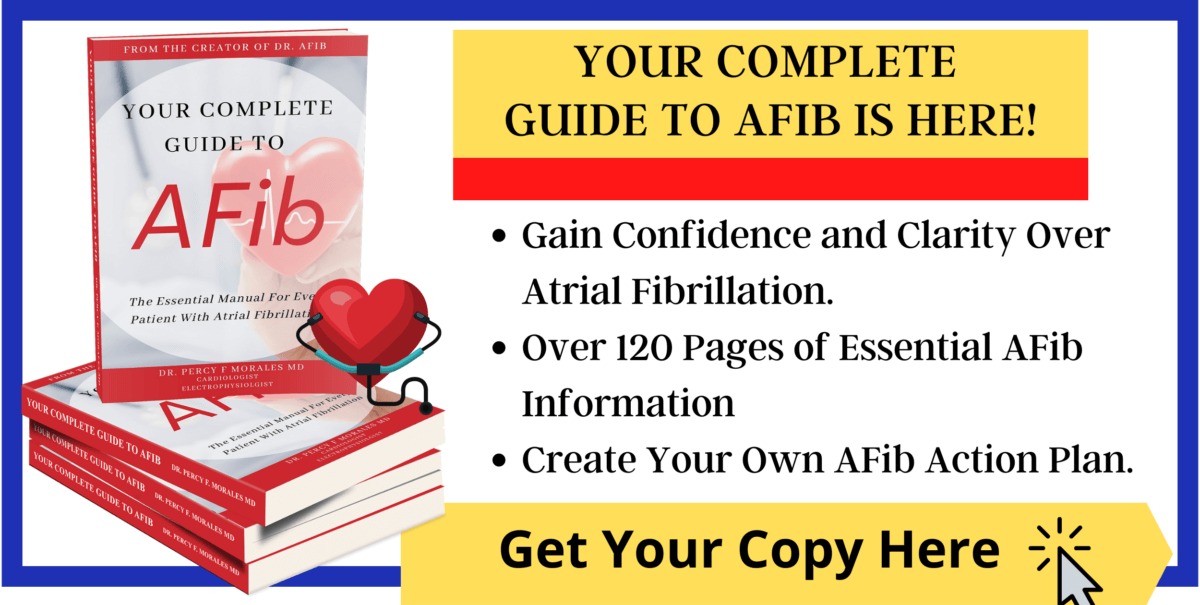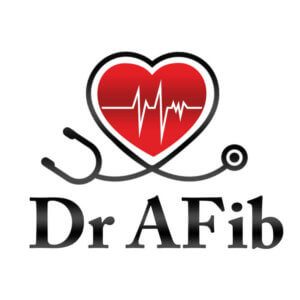I wanted to make this post specifically for a patient who has been recently diagnosed with atrial fibrillation.
If you or a loved one have been recently diagnosed with atrial fibrillation, you may be doing a lot of Google searching out there and trying to get as much information as possible about this condition and maybe feeling overwhelmed about all the information that’s out there.
How do you make sense of all this information? How do you get the best treatment options for you or your loved one? This is what this post is designed for, the person who has just been recently diagnosed with atrial fibrillation.
With my patients, when they’re first diagnosed with atrial fibrillation, I usually tell them that managing atrial fibrillation is like managing two different areas or two different hands. There are symptoms, and then there’s also your risk of stroke. They need to be managed separately. They are two different issues.
Address Your AFib symptoms
Your symptoms are any shortness of breath or heart racing. Some people may also feel chest pain. When you get your episodes of atrial fibrillation, sometimes you will feel dizziness or fatigue. Managing the symptoms is just one phase of managing atrial fibrillation.
Most commonly, when a patient is first diagnosed with atrial fibrillation, they will be started on medical therapy, which is a very appropriate option for a lot of patients as an initial treatment strategy. But there are also multiple options. I urge patients when they’re first diagnosed with atrial fibrillation, just because you’re given a certain medication to control your symptoms doesn’t mean that’s the end-all option for you. There are usually multiple other options in terms of other medications or procedures. There are also rhythm control procedures such as a cardioversion or ablation procedure, which can help keep you more in normal rhythm. These are important treatment strategies when it comes to managing symptoms.
Understand Risk of Stroke
Risk of stroke is a completely separate issue that is separate from managing your symptoms. The risk of stroke from atrial fibrillation is the most important thing at the beginning when it comes to managing atrial fibrillation. You need to make sure that your risk of stroke is assessed and that you get put on the right treatment options to prevent a stroke.
The most commonly used scoring system these days for assessing a patient’s risk of stroke is called the CHADSVASc risk score. There are several online calculators out there to figure out what is your individual risk of stroke. For most people, they will have what’s called a CHADSVASC score of 2 or greater. And in people in these categories, stronger blood thinners like Warfarin, Xarelto, Eliquis, or Pradaxa, are typically recommended. Only people who are in the lowest spectrum of stroke risk is it considered acceptable as an alternative to not use these stronger blood thinners. But most people are going to be recommended to take stronger blood thinners because they just work better for reducing risk of stroke.
In my opinion, these are the most important initial steps for management when somebody is first diagnosed with atrial fibrillation: managing symptoms and managing risk of stroke.
Get a Consultation with an electrophysiologist
Electrophysiology is a subset of cardiology, and we are the experts in heart rhythm disorders such as atrial fibrillation. An electrophysiologist is inherently going to give you more options for managing your atrial fibrillation. Most general care doctors or primary care doctor or even some general cardiologists are most likely going to give somebody conservative medical therapy for their atrial fibrillation, which for many patients is a very appropriate option. However there are many other options, and an electrophysiologist is going to give you more options for your atrial fibrillation, whether that be different medications, or different procedures like a cardioversion or ablation, which may help manage your atrial fibrillation better.
I urge people when they’re first diagnosed with atrial fibrillation to seek a consultation with an electrophysiologist early in your disease process. In earlier stages of AFib, like when you’re recently diagnosed, you actually have a higher chance for successful control of your atrial fibrillation, whether it’s with medications or procedures. Once you’ve had AFib for a while, the success rate of different procedures is lower. Earlier consultation with an electrophysiologist is key to having a better long-term success from atrial fibrillation.
In Conclusion
I hope that this blog article helps patients that are recently diagnosed for atrial fibrillation to help them realize that there are many treatment options available and to get started in the right treatment direction.
Lastly, you are not alone, there are millions of people out there with atrial fibrillation who going through the same symptoms that you are going through. There are many great educational websites and patient support groups out there. Together, we can find the right treatment options.
The Best Atrial Fibrillation Book
Your Complete Guide To AFib: The Essential Manual For Every Patient With Atrial Fibrillation
$15.95 (as of May 28, 2025 13:41 GMT -06:00 - More infoProduct prices and availability are accurate as of the date/time indicated and are subject to change. Any price and availability information displayed on [relevant Amazon Site(s), as applicable] at the time of purchase will apply to the purchase of this product.) The A to Z guide on everything you need to know about atrial fibrillation. Written by AFib expert Dr. Percy Morales MD. Over 120 pages of essential information on medications, procedures, and lifestyles modifications for AFib. Easy to read for every patient.
Shop AFib Products on Amazon
KardiaMobile 6-Lead Personal EKG Monitor – Six Views of The Heart – Detects AFib and Irregular Arrhythmias – Instant Results in 30 Seconds – Works with Most Smartphones - FSA/HSA Eligible
13% Off
KardiaMobile 1-Lead Personal EKG Monitor – Record EKGs at Home – Detects AFib and Irregular Arrhythmias – Instant Results in 30 Seconds – Easy to Use – Works with Most Smartphones - FSA/HSA Eligible
$79.00 (as of May 28, 2025 13:41 GMT -06:00 - More infoProduct prices and availability are accurate as of the date/time indicated and are subject to change. Any price and availability information displayed on [relevant Amazon Site(s), as applicable] at the time of purchase will apply to the purchase of this product.)
Apple Watch Series 9 [GPS 41mm] Smartwatch with Storm Blue Aluminum Case with Silver Sport Band M/L. Fitness Tracker, Blood Oxygen & ECG Apps, Always-On Retina Display
(as of May 28, 2025 06:41 GMT -06:00 - More infoProduct prices and availability are accurate as of the date/time indicated and are subject to change. Any price and availability information displayed on [relevant Amazon Site(s), as applicable] at the time of purchase will apply to the purchase of this product.)
Fitbit Sense 2 Advanced Health and Fitness Smartwatch with Tools to Manage Stress and Sleep, ECG App, SpO2, 24/7 Heart Rate and GPS, Shadow Grey/Graphite, One Size (S & L Bands Included)

OMRON 2-in-1 Upper Arm Blood Pressure Monitor & 1-Lead EKG Monitor - Clinically Validated Blood Pressure Arm Cuff & Machine - Use OMRON Connect App
18% Off
Samsung Galaxy Watch 6 44mm Bluetooth Smartwatch, Fitness Tracker, Personalized HR Zones, Advanced Sleep Coaching, Heart Monitor, BIA Sensor, Health Wellness Insights, Big Screen, US Version, Graphite
9% Off
Natural Rhythm Triple Calm Magnesium 150 mg - 120 Capsules – Magnesium Complex Compound Supplement with Magnesium Glycinate, Malate, and Taurate. Calming Blend for Promoting Rest and Relaxation.
$20.77 ($0.17 / Count) (as of May 28, 2025 15:18 GMT -06:00 - More infoProduct prices and availability are accurate as of the date/time indicated and are subject to change. Any price and availability information displayed on [relevant Amazon Site(s), as applicable] at the time of purchase will apply to the purchase of this product.)
Pure Encapsulations Magnesium (Glycinate) - Supplement to Support Stress Relief, Sleep, Heart Health, Nerves, Muscles, and Metabolism* - with Magnesium Glycinate - 180 Capsules
$44.60 ($0.25 / Count) (as of May 28, 2025 06:46 GMT -06:00 - More infoProduct prices and availability are accurate as of the date/time indicated and are subject to change. Any price and availability information displayed on [relevant Amazon Site(s), as applicable] at the time of purchase will apply to the purchase of this product.)















![Apple Watch Series 9 [GPS 41mm] Smartwatch with Storm Blue Aluminum Case with Silver Sport Band M/L. Fitness Tracker, Blood Oxygen & ECG Apps, Always-On Retina Display #1](https://m.media-amazon.com/images/I/311xwtp4mFL._SL100_.jpg)
![Apple Watch Series 9 [GPS 41mm] Smartwatch with Storm Blue Aluminum Case with Silver Sport Band M/L. Fitness Tracker, Blood Oxygen & ECG Apps, Always-On Retina Display #2](https://m.media-amazon.com/images/I/41j+8AaUGsL._SL100_.jpg)
![Apple Watch Series 9 [GPS 41mm] Smartwatch with Storm Blue Aluminum Case with Silver Sport Band M/L. Fitness Tracker, Blood Oxygen & ECG Apps, Always-On Retina Display #3](https://m.media-amazon.com/images/I/41jIyxZitnL._SL100_.jpg)
![Apple Watch Series 9 [GPS 41mm] Smartwatch with Storm Blue Aluminum Case with Silver Sport Band M/L. Fitness Tracker, Blood Oxygen & ECG Apps, Always-On Retina Display #4](https://m.media-amazon.com/images/I/41IpNJERjCL._SL100_.jpg)
![Apple Watch Series 9 [GPS 41mm] Smartwatch with Storm Blue Aluminum Case with Silver Sport Band M/L. Fitness Tracker, Blood Oxygen & ECG Apps, Always-On Retina Display #5](https://m.media-amazon.com/images/I/31o17yhfYpL._SL100_.jpg)






































